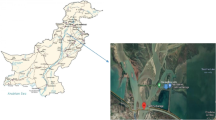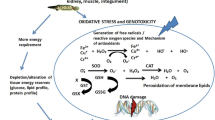Abstract
The present study provides the first data on inorganic element levels (As, Cd, Co, Cr, Cu, Hg, Mn, Pb, Se, and Zn) in juvenile, immature, and adult razorbills (Alca torda) collected along the central coast of Portugal. Element concentrations were assessed by ICP-MS in kidney, liver, muscle, and feathers of 28 razorbills, including 4 juveniles, 17 subadults, and 7 adults. The effect of age and tissue on element accumulation was also assessed. The detected levels in razorbills may indicate a possible contamination risk by Hg and Cr. With respect to bird tissues, higher accumulation of Se and Cd was detected in kidney, Zn and Pb in feathers, and As and Mn in liver. Age was found to affect the accumulation of Cd, Cr, Cu, Hg, and Mn, juveniles presenting higher levels of Cu and Mn than older individuals. In razorbill kidney, Zn–Hg constituted the most significant relationship among metal concentrations. Liver presented the highest number of significant relationships (mostly involving Zn and Co). With regard to feathers, the most significant relationships involved Se, Zn, Cr and Cu concentrations. Positive linear relationships were detected among kidney, liver, and muscle, with emphasis on relationships involving Se and Hg, which may be indicative of similar accumulation/regulation mechanisms in those organs. Element concentrations are discussed in view of possible detoxification mechanisms in seabirds.
Similar content being viewed by others
References
Barrett RT, Anker-Nilssen T, Krasnov YV (1997) Can Norwegian and Russian razorbills Alca torda be identified by their measurements? Mar Ornithol 25:5–8
Braune BM, Gaskin DE (1987) A mercury budget for the Bonaparte’s Gull during autumn moult. Ornis Scand 18:244–250. doi:10.2307/3676891
Burger J (1993) Metals in avian feathers: bioindicators of environmental pollution. Rev Environ Toxicol 5:203–311
Burger J, Gochfeld M (1992) Trace element distribution in growing feathers: additional excretion in feather sheaths. Arch Environ Contam Toxicol 23:105–108
Burger J, Gochfeld M (2000) Metal levels in feathers of 12 species of seabirds from Midway Atoll in the northern Pacific Ocean. Sci Tot Environ 257:37–52. doi:10.1016/S0048-9697(00)00496-4
Dauwe T, Bervoets L, Pinxten R, Blust R, Eens M (2003) Variation of heavy metals within and among feathers of birds of prey: effects of molt and external contamination. Environ Pollut 124:429–436. doi:10.1016/S0269-7491(03)00044-7
Debacker V, Jauniaux T, Coignoul F, Bouquegneau JM (2000) Heavy metals contamination and body condition of wintering guillemots (Uria aalge) at the Belgian coast from 1993 to 1998. Environ Res 84:310–317. doi:10.1006/enrs.2000.4087
del Hoyo J, Elliott A, Sargatal J (1996) Handbook of the birds of the world, vol 3. Hoatzin to Auks. Lynx Editions, Barcelona, Spain
Denneman WD, Douben PET (1993) Trace metals in primary feathers of the barn owl (Tyto alba guttattus) in the Netherlands. Environ Pollut 82:301–310. doi:10.1016/0269-7491(93)90133-9
Dietz R, Riget F, Johansen P (1996) Lead, cadmium, mercury and selenium in Greenland marine animals. Sci Total Environ 186:67–93. doi:10.1016/0048-9697(96)05086-3
Eisler R (1985) Cadmium hazards to fish, wildlife, and invertebrates: a synoptic review. Biological report no. 1.2. U.S. Fish and Wildlife Service, Washington, DC
Eisler R (1986) Chromium hazards to fish, wildlife and invertebrates: a synoptic review. Biological report 1.6. U.S. Fish and Wildlife Service, Washington, DC
Eisler R (1987) Mercury hazards to fish, wildlife and invertebrates: a synoptic review. Biological report 1.1. U.S. Fish and Wildlife Service, Washington, DC
Eisler R (1993) Zinc hazards to fish, wildlife, and invertebrates: a synoptic review. Contaminant Hazard Reviews Report 26. Biological Report 10. U.S. Fish and Wildlife Service, Washington, DC
Elliot JE, Scheuhammer AM, Leighton FA, Pearce PA (1992) Heavy metal and metallothionein concentrations in Atlantic Canadian seabirds. Arch Environ Contam Toxicol 22:63–73. doi:10.1007/BF00213303
Furness RW, Camphuysen KCJ (1997) Seabirds as monitors of the marine environment. ICES J Mar Sci 54:726–737. doi:10.1006/jmsc.1997.0243
Furness RW, Greenwood JJD, Jarvis PJ (1993) Can birds be used to monitor the environment? In: Furness RW, Greenwood JJD (eds) Birds as monitors of environmental change. Chapman and Hall, London, pp 86–143
Hahn E, Hahn K, Stoeppler M (1993) Bird feathers as bioindicators in areas of the German Environmental Specimen Bank—bioaccumulation of mercury in food chains and exogenous deposition of atmospheric pollution with lead and cadmium. Sci Tot Environ 139/140:259–270. doi:10.1016/0048-9697(93)90025-2
Heinz GH (1996) Selenium in birds. In: Beyer WN, Heinz GH, Redmom-Norwood AW (eds) Environmental contaminants in wildlife: interpreting tissues concentrations. CRC Press, Boca Raton, FL, pp 447–458
Hipfner JM, Chapdelaine G (2002) Razorbill (Alca torda). In: Poole A, Gill F (eds) The birds of North America, No. 635. The Birds of North America, Philadelphia, PA
Honda K, Min BY, Talsukawa R (1986) Distribution of heavy metals and their age-related changes in the eastern great white egret Egretta alba modesta in Korea. Arch Environ Contam Toxicol 15:185–197. doi:10.1007/BF01059967
Huettmann F, Diamond AW, Dalzell B, Macintosh K (2005) Winter distribution, ecology and movements of razorbills Alca torda and other auks in the outer Bay of Fundy, Atlantic Canada. Mar Ornithol 33:161–171
Hylland K (2006) Biological effects in the management of chemicals in the marine environment. Mar Pollut Bull 53:614–619. doi:10.1016/j.marpolbul.2006.08.010
ICES (2003) Seabirds as monitors of the marine environment. Tasker ML, Furness RW (eds) ICES Cooperative Research Report No. 258. ICES, Copenhagen
Kim EY, Goto R, Tanabe S, Tanaka H, Tatsukawa R (1998) Distribution of 14 trace elements in tissues and organs of oceanic seabirds. Arch Environ Contam Toxicol 35:638–645. doi:10.1007/s002449900426
Kojadinovic J, Corre M, Cosson RP, Bustamante P (2007a) Trace elements in three marine birds breeding on Reunion Island (western Indian Ocean): Part 1—Factors influencing their bioaccumulation. Arch Environ Contam Toxicol 52:418–430. doi:10.1007/s00244-005-0225-2
Kojadinovic J, Bustamante P, Corre M, Cosson RP (2007b) Trace elements in three marine birds breeding on Reunion Island (western Indian Ocean): Part 2—Factors influencing their detoxification. Arch Environ Contam Toxicol 52:431–440. doi:10.1007/s00244-005-8225-9
Kubota R, Kunito T, Tanabe S (2001) Arsenic accumulation in the liver tissue of marine mammals. Environ Pollut 115:303–312. doi:10.1016/S0269-7491(01)00099-9
Kunito T, Kubota R, Fujihara J, Agusa T, Tanabe S (2008) Arsenic in marine mammals, seabirds, and sea turtles. Rev Environ Contam Toxicol 195:31–69. doi:10.1007/978-0-387-77030-7_2
Langston WJ, Chesman BS, Burt GR, Pope ND, McEnvoy J (2002) Metallothionein in liver of eels Anguilla anguilla from the Thames Estuary: an indicator of environmental quality? Mar Environ Res 53:263–293. doi:10.1016/S0141-1136(01)00113-1
Lavers JL, Jones IL, Diamond AW (2007) Natal and breeding dispersal of razorbills (Alca torda) in Eastern North America. Waterbirds 30:588–594
Mendes P, Eira C, Torres J, Soares AMVM, Melo P, Vingada J (2008) Toxic element concentration in the Atlantic gannet Morus bassanus (Pelecaniformes, Sulidae) in Portugal. Arch Environ Contam Toxicol. doi:10.1007/s00244-008-9134-5
Nam D-H, Anan Y, Ikemoto T, Okabe Y, Kim E-Y, Subramanian A, Saeki K, Tanabe S (2005) Specific accumulation of 20 trace elements in great cormorants (Phalacrocorax carbo) from Japan. Environ Pollut 134:503–514. doi:10.1016/j.envpol.2004.09.003
Neff JM (1997) Ecotoxicology of arsenic in the marine environment. Environ Toxicol Chem 16:917–927. doi:10.1897/1551-5028(1997)016<0917:EOAITM>2.3.CO;2
Nettleship DN, Birkhead TR (1985) The Atlantic Alcidae. Academic Press, London
Niecke M, Heid M, Kruger A (1999) Correlations between melanin pigmentation and element concentration in feathers of white-tailed eagles (Haliaeetus albicilla). J Ornithol 140:355–362. doi:10.1007/BF01651032
NRC (National Research Council) (1983) Risk assessment in the federal government. Managing the process. National Academy Press, Washington, DC
Outridge PM, Scheuhammer AM (1993) Bioaccumulation and toxicology of chromium: implications for wildlife. Rev Environ Contam Toxicol 130:31–77
Pérez-López MP, Cid F, Oropesa L, Fidalgo LE, Beceiro AL, Soler F (2006) Heavy metal and arsenic content in seabirds affected by the Prestige oil spill on the Galician coast (NW Spain). Sci Tot Environ 359:209–220. doi:10.1016/j.scitotenv.2005.04.006
Savinov VM, Gabrielsen GW, Savinova TN (2003) Cadmium, zinc, copper, arsenic, selenium and mercury in seabirds from the Barents Sea: levels, inter-specific and geographical differences. Sci Tot Environ 306:133–58. doi:10.1016/S0048-9697(02)00489-8
Scheuhammer AM (1987) The chronic toxicity of aluminium, cadmium, mercury, and lead in birds: a review. Environ Pollut 46:263–295. doi:10.1016/0269-7491(87)90173-4
Schneider R, Steinhagen-Schneider G, Drescher HE (1985) Organochlorines and heavy metals in seals and birds from the Weddell Sea. In: Seigfried WR, Condy PR, Laws RM (eds) Antarctic nutrient cycles and food webs. Springer-Verlag, Berlin, pp 652–655
SEO/BirdLife (2003) Aves petroleadas. SEO/BirdLife, Conselleria de Medi Ambient (Govern de les Illes Balears) e Consellería de Medio Ambiente (Xunta de Galicia)
Stewart FM, Thompson DR, Furness RW, Harrison N (1994) Seasonal variation in heavy metal levels in tissues of Common Guillemots, Uria aalge from Northwest Scotland. Arch Environ Contam Toxicol 27:168–175. doi:10.1007/BF00214259
Stewart FM, Phillips RA, Bartle JA, Craig J, Shooter D (1999) Influence of phylogeny, diet, moult schedule and sex on heavy metal concentrations in New Zealand Procellariiformes. Mar Ecol Prog Ser 178:295–305. doi:10.3354/meps178295
Thompson DR (1996) Mercury in birds and terrestrial mammals. In: Beyer WN, Heinz GH, Redmon-Norwood AW (eds) Environmental contaminants in wildlife. Interpreting tissue concentrations. CRC Press, Boca Raton, FL
Thompson DR, Furness RW, Barrett RT (1992) Mercury concentrations in variation in heavy metal levels in tissue of common guillemots, seabirds from colonies in the Northeast Atlantic. Arch Environ Contam Toxicol 23:383–389. doi:10.1007/BF00216249
Upton AJ, Pickerell G, Heubeck M (2000) Seabird numbers and breeding success in Britain and Ireland. JNCC, Peterborough
Walsh P (1990) The use of seabirds as monitors of heavy metals in the marine environment. In: Furness RW, Rainbow PS (eds) Heavy metals in the marine environment, vol 10. CRC Press, Boca Raton, FL, pp 183–204
Yamamoto Y, Kanesakti S, Kuramochi S, Miyazakiy N, Watanukiy Y, Naito Y (1996) Comparison of trace element concentrations in tissues of the chick and adult Adelie Penguins. Proc NIPR Symp Polar Biol 9:253–262
Acknowledgments
This study was partially supported by project HP 2005-0011 (ACIN) of the Secretaría de Estado de Educación, Universidades, Investigación y Desarrollo (SEID) and Conselho de Reitores das Universidades Portuguesas (CRUP), and by fellowship SFRH/BPD/27014/2006 provided by the Fundação para a Ciência e Tecnologia of the Portuguese MCTES. The authors wish to thank all personnel at the Serveis Científics i Tècnics of the University of Barcelona, Spain.
Author information
Authors and Affiliations
Corresponding author
Rights and permissions
About this article
Cite this article
Ribeiro, A.R., Eira, C., Torres, J. et al. Toxic Element Concentrations in the Razorbill Alca torda (Charadriiformes, Alcidae) in Portugal. Arch Environ Contam Toxicol 56, 588–595 (2009). https://doi.org/10.1007/s00244-008-9215-5
Received:
Accepted:
Published:
Issue Date:
DOI: https://doi.org/10.1007/s00244-008-9215-5




